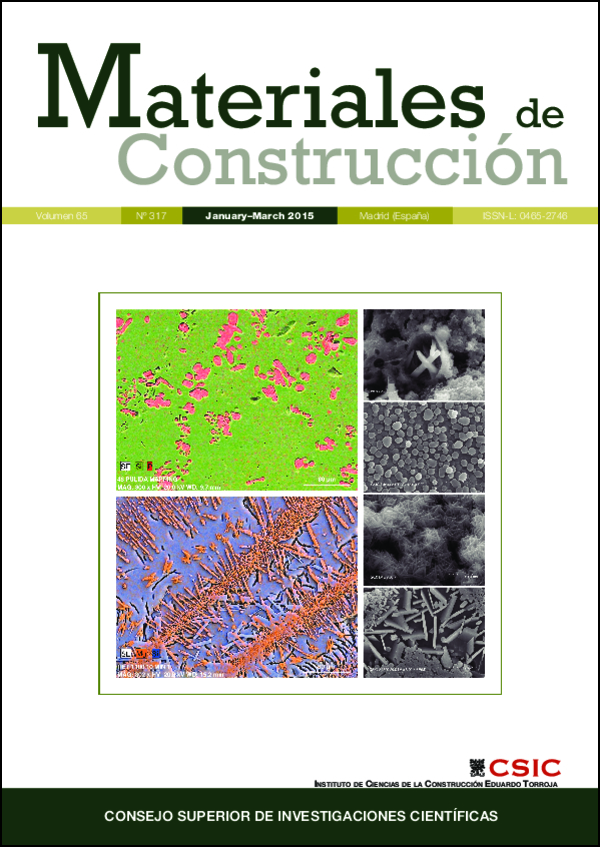Validation of a dynamic modulus predictive equation on the basis of spanish asphalt concrete mixtures
DOI:
https://doi.org/10.3989/mc.2015.01114Keywords:
Asphalt mixture, Asphalt binder, Dynamic modulus, Mechanistic-Empirical DesignAbstract
Dynamic modulus is defined as the ratio of peak cyclic stress to peak cyclic strain under harmonic loading. It is one of the most important properties of asphalt mixtures, since it determines the strain response characteristics as a function of loading rate and temperature. Different simplified models exist that can predict this variable from mixture composition and binder rheological data, with Witczak and Hirsh models being the most widely accepted. These models have been evaluated in the present study, on the basis of 352 data points from eight asphalt concrete mixtures that were tested between −5 and 60 °C. A new model is also formulated which improves predictions of the previous ones for Spanish mixtures, even though it is a relatively simple equation that requires very limited binder rheological data compared to Witczak and Hirsch models.
Downloads
References
1. Mateos, A.; Ayuso, J.P.; Jáuregui, B.C. (2013) Evaluation of Structural Response of Cracked Pavements at CEDEX Transport Research Center Test Track. Transportation Research Record: Journal of the Transportation Research Board, 2367 [1], 84–94. http://dx.doi.org/10.3141/2367-09
2. Bonaquist, R. (2011) NCHRP Report 702: Precision of the Dynamic Modulus and Flow Number Tests Conducted with the Asphalt Mixture Performance Tester. Transportation Research Board.
3. CalME Version 1.0. (2010) California Department of Transportation, Sacramento.
4. Mechanistic-Empirical Pavement Design Guide, Interim Edition: A Manual of Practice (2008). AASHTO, Washington, DC.
5. Andrei, D.; Witczak, M.W.; Mirza, M.W. (1999) Development of a revised predictive model for the dynamic (complex) modulus of asphalt mixtures. Development of the 2002 Guide for the Design of New and Rehabilitated Pavement Structures, NCHRP. PMCid:PMC25302
6. Christensen Jr, D.W.; Pellinen, T.; Bonaquist, R.F. (2003) Hirsch model for estimating the modulus of asphalt concrete. Journal of the Association of Asphalt Paving Technologists, 72.
7. Bari, J.; Witczak, M.W. (2006) Development of a New Revised Version of the Witczak E* Predictive Model for Hot Mix Asphalt Mixtures (With Discussion). Journal of the Association of Asphalt Paving Technologists, 75.
8. Schwartz, C.W. (2005, January) Evaluation of the Witczak dynamic modulus prediction model. In Proceedings of the 84th Annual Meeting of the Transportation Research Board, Washington, DC (No. 05-2112).
9. Robbins, M. (2009) An Investigation into Dynamic Modulus of Hot-Mix Asphalt and Its Contributing Factors. Ph. D. Thesis. Auburn University.
10. Birgisson, B.; Sholar, G.; Roque, R. (2005) Evaluation of a predicted dynamic modulus for Florida mixtures. Transportation Research Record: Journal of the Transportation Research Board, 1929 [1], 200–207. http://dx.doi.org/10.3141/1929-24
11. Shen, S.; Yu, H. (2011) An investigation of dynamic modulus and flow number properties of asphalt mixtures in Washington State. United States Department of Transportation, Washington, D.C.
12. Al-Khateeb, G.; Shenoy, A.; Gibson, N.; Harman, T. (2006) A new simplistic model for dynamic modulus predictions of asphalt paving mixtures. Journal of the Association of Asphalt Paving Technologists, 75.
13. Silva, H.N. (2009) Caracterização viscoelástica linear de misturas asfálticas: Operacionalização Computacional e Análise pelo Método dos Elementos Finitos. Dissertação de Mestrado, Programa de Pós-Graduação em Engenharia de Transportes, UFC.
14. Marasteanu, M.O.; Anderson, D.A. (1999, May) Improved model for bitumen rheological characterization. In Eurobitume Workshop on Performance Related Properties for Bituminous Binders. Brussels, Belgium: European Bitumen Association.
15. Huang, B.; Shu, X.; Bass, J. (2008) Investigation of Simple Performance Characteristics of Plant-Produced Asphalt Mixtures in Tennessee. Transportation Research Record: Journal of the Transportation Research Board, 2057 [1], 140–148. http://dx.doi.org/10.3141/2057-17
16. Bonaquist, R.; Pellinen, T.; Witczak, M.W. (1998) Development of relationship between binder viscosity and stiffness. Superpave Support and Performance Models Management. Department of Civil Engineering, University of Maryland, College Park, Maryland.
17. Bari, J.; Witczak, M.W. (2007) New predictive models for viscosity and complex shear modulus of asphalt binders: for use with mechanistic-empirical pavement design guide. Transportation Research Record: Journal of the Transportation Research Board, 2001 [1], 9–19. http://dx.doi.org/10.3141/2001-02
18. Dongre, R.; Myers, L.; D'Angelo, J.; Paugh, C.; Gudimettla, J. (2005) Field Evaluation of Witczak and Hirsch Models for Predicting Dynamic Modulus of Hot-Mix Asphalt (With Discussion). Journal of the Association of Asphalt Paving Technologists, 74.
19. Onofre, F.C. (2012) Avaliação do comportamento mecânico de misturas asfálticas produzidas com ligantes asfálticos modificados por ácido polifosfórico e aditivos poliméricos, enfatizando a resistência à deformação permanente. M.SC. Thesis. Universidade Federal do Ceará.
20. Mirza, M.W.; Witczak, M.W. (1995) Development of a Global Aging System for Short and Long Term Aging of Asphalt Cements. Journal of the Association of Asphalt Paving Technologists, 64.
21. Ruiz, A.; Pérez, I. (2002) Influencia de los betunes en las deformaciones plásticas de las mezclas bituminosas. Monografía M-72, Centro de Estudios y Experimentación de Obras Públicas-CEDEX, 192.
Published
How to Cite
Issue
Section
License
Copyright (c) 2015 Consejo Superior de Investigaciones Científicas (CSIC)

This work is licensed under a Creative Commons Attribution 4.0 International License.
© CSIC. Manuscripts published in both the print and online versions of this journal are the property of the Consejo Superior de Investigaciones Científicas, and quoting this source is a requirement for any partial or full reproduction.
All contents of this electronic edition, except where otherwise noted, are distributed under a Creative Commons Attribution 4.0 International (CC BY 4.0) licence. You may read the basic information and the legal text of the licence. The indication of the CC BY 4.0 licence must be expressly stated in this way when necessary.
Self-archiving in repositories, personal webpages or similar, of any version other than the final version of the work produced by the publisher, is not allowed.
















